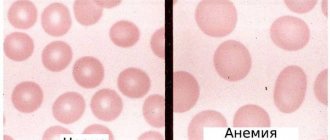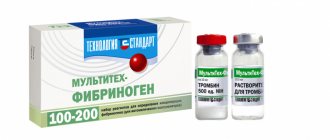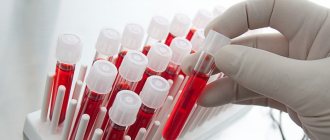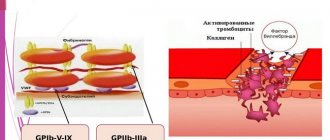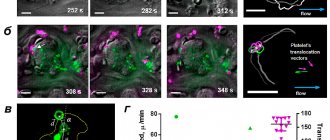- Laboratory study PDW - P latelet D istribution W idth - data that shows the distribution of platelet forms relative to blood volume;
- PLT (platelets) is an abbreviation for platelets; these cells are responsible for blood clotting;
- Diagnostic value is a test for platelet anisocytosis, that is, a change in the ratio of different types of PLT;
- Changes in platelet size are most often associated with a deficiency of vitamins A and B12, and a lack of iron;
- The platelet distribution test is part of the CBC, a complete blood count (formerly called a clinical test).
DETAILS
What does a platelet distribution test mean?
Such a marker in the study will show whether there is a threat of myeloproliferative diseases - pathological changes. Directly when considering the test results for platelet indices, we are talking about the following pathologies:
- Malignant hematological lesions;
- Hemorrhagic syndrome (bleeding);
- Thrombocytosis (risk of vascular blockage);
- Autoimmune diseases.
With the help of such an analysis in the laboratory, it becomes clearly visible which forms of PLT predominate relative to the total platelet mass. This is called heterogeneity, that is, heterogeneity in the ratio between elements within one group of blood cells. Normally, all forms of platelets are present in the blood, and they are all in a certain balance. However, with one of the diseases, there is a pathological increase in the mass of those forms that, due to their structure, cannot cope with the tasks of platelets.
Platelet shapes
This type of blood cell can be called secondary: a platelet is part of megakaryocytes, which are one of the types of bone marrow products.
The lifespan of platelets is short; these blood cells are renewed within 5-11 days. These blood cells differ in size and degree of maturity:
- Young
They make up less than 1% of the total mass of PLT, their increase is always associated with an active regeneration process in the red bone marrow. Increased production of new blood cells is associated with its loss for various reasons, including in women during the monthly cycle.
- Mature
Among the total volume of platelets, these forms are present in the largest mass in a healthy body: 80-95%. It is the mature ones that perform most of the functions assigned to PLT: coagulation and arrest of blood, that is, its aggregation or adhesion.
- Old
Their presence is limited to 2.2 - 5%; blood with a volume of old platelets greater than this norm indicates the risk of developing malignant tumors or their presence.
- Forms of irritation
0.8-2.3-3% of the total platelet mass, occurs as an error in the process of separation from the megakaryocyte. They are practically non-functional, the ability to stick together is extremely low, and are not suitable for performing tasks characteristic of platelets.
- Degenerative
Such forms of platelets are not found in healthy people, a mass of 0-0.2% is considered acceptable, and everything that goes beyond the norm is detected in chronic severe diseases of the hematopoietic system.
Excesses in the last two forms - degenerative and irritation - indicate anisocytosis, that is, an atypical ratio of different types of platelets, and, as a consequence, pathology.
Why does PDW increase?
All other platelet indices as part of the laboratory test, as well as other parameters of the blood flow test, including the leukocyte formula, ESR (erythrocyte sedimentation rate), etc., add information to the interpretation of this part of the analysis.
An increase in only one point out of all parameters of a platelet test indicates more a violation of the rules for preparing for the OAC test or an error in processing the results than an actual disease.
WHAT CAN AFFECT BLOOD TEST RESULTS
- inflammation . Platelets always react sensitively to damage or infection; even a harmless cosmetic procedure on the eve of the blood sampling procedure can lead to a temporary increase in the PLT distribution index.
– medicines . It’s impossible to determine which ones exactly; it all depends on the purpose of therapy. But it is recommended to exclude even vitamins.
- menstrual cycle . Refers to conditions of blood loss.
– pregnancy . Blood clotting inevitably increases, the body undergoes a global restructuring.
- physical exercise . Blood flow accelerates, production of all types of blood cells increases.
Reasons for lowering PWD
When the level decreases, it is always worth suspecting a disease; deviations to a lesser extent from the reference values in the analyzes are interpreted as pathologies of inhibition of hematopoietic mechanisms and a consequence of their treatment:
- diseases associated with the bone marrow (myelodysplastic syndrome), metastases to the bone marrow;
-chemotherapy or chemical poisoning;
-leukemia (blood cancer);
-radiation sickness;
-thrombocytopenia (lack of platelets in the blood);
- chronic hepatitis (liver disease, closely related to blood, its quality, filtration, etc.);
- anemia (due to deficiency of vitamins B9 and B12).
Norms in blood analysis of platelet formula and platelet distribution
Micronutrients and platelets
It would be incorrect to talk about a direct connection between vitamins, macro- and microelements with platelets, their maturation and proper activity. However, full-fledged hematopoiesis - the formation of blood cells in the red bone marrow - is impossible without additional nutrition. Two elements are of primary importance:
Vitamin B9 – folic acid. This is the speed and quality of cellular renewal, amino acid metabolism.
Water-soluble, that is, not accumulated in tissues, this compound is of primary importance for regulating the process of development of new cells, including blood and its formed elements. This folate is also actively involved in processes associated with hematopoiesis.
A short-term lack of vitamin B9 without aggravating factors will not negatively affect the processes of cell division. However, an increasing deficiency of folic acid leads to the fact that the place of mature, fully functional blood cells (platelets and red blood cells) is taken by immature cells - megaloblasts .
The presence of these giant, but completely functionally incapable cells leads to the appearance of folate deficiency (megaloblastic) anemia. However, vitamin B9 deficiency is not limited to this, and in addition to the deterioration of blood functionality, those processes in the body that depend on cell division - that is, everything - suffer.
Physiological factors:
- Cardiovascular pathologies
- Oncological diseases
- Premature loss of skin tone
- Difficulty conceiving
Depression, anxiety and a general deterioration of the psycho-emotional state are also an important aspect, although to a lesser extent dependent on the presence of vitamin B9 in the blood.
Vitamin B12 is a representative of the cobalamin group, and in particular the compound cyanocobalamin, which can be converted into a form of coenzyme (coenzyme), an active accelerator of enzyme action. Vitamin B12 is also known as an anti-anemic compound, and together with a lack of vitamin B9 leads to severe pathologies of the hematopoietic system.
Let us not be mistaken in recalling that an imbalance of any micronutrients always leads to a deterioration in well-being. The role of vitamins at the cellular level is so important that the lack of just one, especially for a long time, leads to malfunctions in the transport chain, which is followed by disruption of the delivery of nutrition to cells through the blood, and the accumulation of excess undelivered compounds.
No less important is the interaction of vitamins, micro-macroelements with each other.
Vitamins E and C protect the most important antioxidant - vitamin A - from oxidation. In order for retinol A to take one of its active forms, zinc is also needed. In turn, vitamin A improves the absorption of iron, which is necessary for the prevention of anemia and is required for blood loss. Vitamin C helps the gland to be absorbed into the gastrointestinal tract, but it also prevents the liver from accumulating vitamin A, which is necessary to protect cells from premature death.
This cycle of interactions and confrontations in the body of each person is individual and endless. But this seemingly complex system, but impeccably balanced by evolution, leads to a clear understanding that uncontrolled intake of vitamins and micronutrients is at least useless, and in a number of diseases can cause more harm than good.
Calculating a personal formula of micronutrients is a sound decision and leads to the need to monitor health status. Blood tests provide a clear, up-to-date, and, more importantly, personalized view of most processes in the body.
Indications for the study
There are quite a lot of reasons for diagnosis. In more detail:
- Bone marrow disorders. Myeloproliferative diseases and conditions in which the maturation of formed cells is disrupted. Not only platelets, but also red white blood cells. Also other bone marrow disorders. Up to blood cancer.
Unfortunately, the analysis is too general to show specific changes. Deviations by PDW are merely indications of a violation. But it is by no means an exhaustive diagnostic method. A bone marrow puncture and other tests will be required.
- Previously diagnosed thrombocytopathy. A condition in which the functional activity of blood cells decreases, but their number remains at a normal level. Happens quite often. It practically never happens to be primary. As a rule, the disorder is caused by other pathological processes.
- Cancer diseases. Regardless of type, stage and location. The platelet distribution index (PDW) may well be a nonspecific marker of the oncological process.
The reason for this is bone marrow dysfunction. It can no longer function in “normal” mode. Consequently, cell maturation slows down. Precursors and old forms of platelets circulate in the bloodstream. This is a fairly typical clinical picture of cancer.
- Preparing for hospitalization. The study of the platelet distribution index is included in the mandatory list. Especially if doctors are planning surgical treatment or invasive procedures. The decrease clearly speaks in favor of coagulopathies.
Attention:
Coagulation disorders are a contraindication for surgical treatment.
- Therapy control. The study of the platelet distribution index is also practiced as part of dynamic observation, when specialists assess the patient’s health status after therapy. This is necessary, for example, in the treatment of megaloblastic, iron deficiency anemia and other pathological processes.
- Preventive examinations. Semiannually. Typically, PDW testing is performed as part of a routine blood test. Therefore, the patient does not have to break down and run for additional research.
The list of indications is approximate. The doctor, at his own discretion and discretion, prescribes the study. If there is a reason for it.
Where to get a blood test for PDW
We have no doubt that you take your own health seriously and value the quality of life that is possible in the absence of disease. Blood tests are one of the good and useful habits, and you are a frequent visitor to the laboratory of your favorite medical clinic. It is recommended to undergo a check-up at least for the basic parameters of blood composition and quality at least twice a year.
If we talk directly about the study of the width of platelet distribution, this index is a mandatory part of the OAC for the platelet formula and is submitted to any medical center. clinic.
Perhaps there is no time to visit a doctor for no reason, solely for preventive purposes, so we offer a more convenient way: the tests will be carried out in one of the laboratories of medical clinics, but the collection of biomaterial will be carried out at your home in a calm environment for you or at a specified location .
- Sterile;
- Personnel of the highest category with medical education and work experience;
- Up to 50 research parameters;
- Free with bioniq BALANCE subscription
Information from the analysis is a priority principle for creating a personalized complex of micronutrients, vitamins needed specifically at the current moment.
Reasons for falsely high results
Among them:
- Wrong analysis.
- Violations of sample processing techniques.
Sometimes the patient himself may be to blame. Many factors influence the final result.
Deviation occurs in the following cases:
- Intense physical activity. Approximately a day before taking the test, you should not practice excessive mechanical activity.
- Smoking. It is abandoned a few days before the study.
- Eating. Food should be avoided 3-4 hours before blood sampling. This way the results will be more accurate.
- It is not advisable to take the test during menstruation, pregnancy and breastfeeding. Because the results will definitely be false. Possibly within the margin of error.
- You should also not drink alcohol, overheat or become hypothermic. In about 1-2 days. Deviations within small values are possible. If other analysis indicators are normal, such errors are not paid attention to.
When the platelet distribution index is increased, this means that the number of young cells is greater than the number of old, waste structures. As a rule, blood diseases are to blame.
It often turns out that there is no pathological process and the deviation is due to the actions of the patient. Smoking, leading an unhealthy lifestyle.
How to normalize platelet levels
To restore the level of platelets and increase their level in the blood, first of all you need to stop psychological stress (being nervous, quarreling, experiencing stress), and also perform as little physical activity as possible. But this is not enough to restore normality. Therefore it is necessary:
- Take special medications that restore (increase or decrease) the number of platelets in the blood. Use such medications only after consulting a doctor.
- To eat well. It is necessary to strictly reduce to a minimum value, and it is best to exclude from the diet all pickled foods, spicy foods, alcoholic drinks, seaweed, grapes, and cucumbers. But almonds, dill, parsley, bananas, fish, and liver should be added to your diet.
- If your platelet count is low, you should stop taking medications that reduce the number of platelets in your blood. In most cases, these are antidepressants and antibiotics.
- Consume more vitamins C, B12 and A.
- In addition, you need to start leading a healthy lifestyle, get rid of bad habits, do not drink alcohol, do not smoke, watch your sleep, and do not engage in traumatic sports.
Additional examinations
Supportive measures allow us to establish the correct diagnosis:
- Oral interview with a hematologist.
- Anamnesis collection.
- Bone marrow puncture. It is prescribed to clarify the nature of the pathology.
- Assessment of the size of the spleen, ultrasound of the digestive tract. At the same time, the liver is examined.
- Biochemistry of blood.
- MRI or CT as needed. With contrast enhancement with gadolinium and iodine, respectively.
The question of what caused the index to rise or fall is complex. The doctors decide. Treatment is carried out as needed. It is mainly etiotropic, that is, aimed at correcting the underlying cause. Primary disease.
Treatment
The doctor prescribes treatment only after completing an accurate diagnosis. Drug therapy is prescribed to eliminate the disease. In the case of cancer, spinal cord cell transplantation and chemotherapy are prescribed.
To maintain normal levels, you need to periodically visit a therapist, who will give you a referral for testing. The foundation of good health is maintaining a healthy lifestyle. Maintain hydration, since the blood flow consists of 89% plasma. The process of renewal and circulation occurs when drinking water enters the body.
A balanced diet will help increase your immunity level, since 80% of immunity is located in the intestines. It is worth excluding harmful products, products of synthetic origin, products with a large number of chemical additives. Walk outside every day in any weather. Do not self-medicate, as medications affect the body as a whole.
These are simple rules that are easy to implement. Don’t delay making timely diagnoses if you have any ailments.
Significance in diagnosis
First of all, by determining thrombocrit indicators, the following aspects are established:
- Determination of the risk of bleeding, increased thrombosis (thrombocytosis condition).
- Assessment of the benefit/risk ratio when prescribing certain medications.
The most well-known reasons for determining this indicator in the blood are:
- The patient has a high temperature of unknown origin.
- Evaluation of treatment with immunosuppressive drugs.
- Severe viral, bacterial, fungal infection of the body.
- The patient is on artificial ventilation.
- Complications after organ transplantation.
Important. It must be taken into account that any change in the number of platelet germ cells - an increase (thrombocytosis), a decrease (thrombocytopenia), a change in shape, aggregation - immediately affects the thrombocrit numbers
To assess platelet distribution in peripheral blood, it is necessary to know its normal values.


